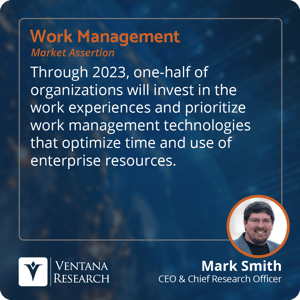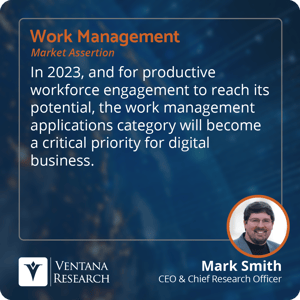To maximize the value of the workforce and the work conducted, organizations need to increase the effectiveness of workers assigned to critical, interrelated tasks. Doing so requires a commitment to planning the best use of workers and resources. Failing to do so can limit an organization’s ability to reach essential milestones and complete work related to business processes with customers, partners and across the supply chain.
The business of work management is to ensure that work related to projects and programs is well-managed, and that repetitive tasks are supported by technology. Armed with automation, the opportunity exists to use intelligence about work and available resources to guide future actions and decisions.
The challenge is that much of an organization’s technology can undermine productivity. For example, a constant flow of email messages, phone calls and instant messages can distract workers from the task at hand. The omnipresence of smartphones and tablets adds to the turmoil. Businesses must explore how to adapt to the rhythms and issues of work today, which include interruptions of text messages, social media notifications and virtual meetings. But it is important to provide technologically supported work experiences that are productive and simple for the workforce. Ventana Research asserts that through 2023, one-half of organizations will invest in the work experiences and prioritize work management technologies that optimize time and use of enterprise resources.
 In our benchmark research on next-generation business planning, fewer than one-half (40%) of organizations said that project plans are accurate. That is less than the overall average (47%) of accuracy across all types of planning. The research also finds significant variances in the accuracy of particular types of planning. In this regard, work management can be more challenging as resources have more varied dependencies and characteristics that are competing against time to get tasks completed.
In our benchmark research on next-generation business planning, fewer than one-half (40%) of organizations said that project plans are accurate. That is less than the overall average (47%) of accuracy across all types of planning. The research also finds significant variances in the accuracy of particular types of planning. In this regard, work management can be more challenging as resources have more varied dependencies and characteristics that are competing against time to get tasks completed.
To unify work management, organizations should adopt an application that provides an integrated view of all activities and tasks and supports the use of other available job-specific tools. Such tools help define the variety of available people and material resources and tracks their utilization. The software should be able to operate beyond the enterprise to resources that are critical for the project, including contractors, customers, partners and suppliers. Dedicated work management software enables a range of key capabilities, including the ability to define and manage initiatives and projects independently or as part of a portfolio, identifying and tracking to completion tasks across resources, defining and adjusting budgets for projects that are combined into portfolios, assessing the actual versus plan costs of work and resources, determining the financial impact of changes, and performing scenario and trade-off planning to optimize work and resources.
Our research finds that fewer than 10% of organizations perform work management and monitor the tasks conducted by resources very well. The value of a dedicated application is underscored when considering the potential shortcomings and the advantages of overcoming them. This return on investment has established work management as a category where technology is advancing rapidly to meet pressing needs. Ventana Research asserts that in 2023, and for productive workforce engagement to reach its potential, the work management applications category will become a critical priority for digital business.
 Applications designed for other purposes — from customer experience, professional services automation and enterprise resource planning – have unique methods to define and execute work. In effect, they prevent resources from working together across departments and business processes to achieve desired outcomes. This is especially true of desktop spreadsheets, which undermine efficiency in managing work across departments and the enterprise. Our research shows that about two-thirds of organizations use spreadsheets for project planning alone (32%) or with other applications (30%). Yet 40% of those organizations admitted that spreadsheets make it difficult to manage project planning processes.
Applications designed for other purposes — from customer experience, professional services automation and enterprise resource planning – have unique methods to define and execute work. In effect, they prevent resources from working together across departments and business processes to achieve desired outcomes. This is especially true of desktop spreadsheets, which undermine efficiency in managing work across departments and the enterprise. Our research shows that about two-thirds of organizations use spreadsheets for project planning alone (32%) or with other applications (30%). Yet 40% of those organizations admitted that spreadsheets make it difficult to manage project planning processes.
Effective dedicated applications manage work efficiently and provide capabilities for collaboration and mobility that enable workers to use them at any time or place. A large majority (85%) of research participants said they manage planning well and collaborate effectively or very effectively. However, only one-half (49%) of all organizations reported the ability to collaborate across all project plans. Capabilities for collaboration and mobility are part of the trend toward making business software as easy to use as the applications people rely on when not at work. We therefore recommend that usability be a key yardstick in evaluating products for work and resource management.
Making an effective business case for adopting such software requires aligning the investment to critical objectives such as optimizing the customer experience and digitizing business processes. Improvement starts with unifying processes and applications that manage work and resources. Incremental changes that are part of a continuous improvement cycle save time and money related to human and material resources. But to benefit from work management, organizations need to be willing to change the current approach and, in many cases, the bad habits of alternative approaches. Work management is not just about automation but requires intelligence regarding work requirements that can guide notification of future issues to address.
To assess the strategic value of managing work systematically, identify financial, customer and product benefits. Among the most important are the ability to:
- Maximize the utilization of all resources — internally and externally — by prioritizing work to completion.
- Improve the engagement of workers by increasing collaboration across teams.
- Provide visibility into the impact of work completed.
- Increase the organization’s responsiveness through the ability to make changes as needed.
- Assign appropriate responsibilities to workers and managers — and even third parties — that simplifies management, increases productivity and improves potential outcomes in a timely manner through the ability to prioritize work.
Even modest improvements to productivity and the ability to prioritize activities and assigned tasks can justify the cost of investing in dedicated software. Combined, these steps enable organizations to align work and resources across departmental boundaries to larger objectives. But the real benefit should come from ensuring the software has the ability to apply intelligence to past, current and future work to continuously assess and engage any risk points leading to less-than-agreed-upon success.
Organizations are apt to put off investments and priorities that appear complex, but getting started may be easier than it seems when following these five steps:
- Assess all the ways your organization currently manages work and associate-related resources.
- Identify the inefficiencies in current formal and informal planning approaches and prioritize the challenges.
- Quantify the value that will be realized from eliminating efficiencies and the value of improvement to the organization.
- Evaluate choices for technology that streamlines work processes and provides intelligence about work that can meet today’s challenges as well as future opportunities.
- Identify ways to maximize the potential of work and resources through unified processes and applications that use common data and analytics.
Effective technology for work management cannot be ignored. Organizations must minimize costs and maximize efficiencies and effectiveness of work and associated internal and external resources. Once you understand the technology and applications available and assess your organization’s requirements, you’ll be able to minimize complexity and increase efficiency and effectiveness to innovate faster.
Regards,
Mark Smith

 In our benchmark research on next-generation business planning, fewer than one-half (40%) of organizations said that project plans are accurate. That is less than the overall average (47%) of accuracy across all types of planning. The research also finds significant variances in the accuracy of particular types of planning. In this regard, work management can be more challenging as resources have more varied dependencies and characteristics that are competing against time to get tasks completed.
In our benchmark research on next-generation business planning, fewer than one-half (40%) of organizations said that project plans are accurate. That is less than the overall average (47%) of accuracy across all types of planning. The research also finds significant variances in the accuracy of particular types of planning. In this regard, work management can be more challenging as resources have more varied dependencies and characteristics that are competing against time to get tasks completed. Applications designed for other purposes — from customer experience, professional services automation and enterprise resource planning – have unique methods to define and execute work. In effect, they prevent resources from working together across departments and business processes to achieve desired outcomes. This is especially true of desktop spreadsheets, which undermine efficiency in managing work across departments and the enterprise. Our research shows that about two-thirds of organizations use spreadsheets for project planning alone (32%) or with other applications (30%). Yet 40% of those organizations admitted that spreadsheets make it difficult to manage project planning processes.
Applications designed for other purposes — from customer experience, professional services automation and enterprise resource planning – have unique methods to define and execute work. In effect, they prevent resources from working together across departments and business processes to achieve desired outcomes. This is especially true of desktop spreadsheets, which undermine efficiency in managing work across departments and the enterprise. Our research shows that about two-thirds of organizations use spreadsheets for project planning alone (32%) or with other applications (30%). Yet 40% of those organizations admitted that spreadsheets make it difficult to manage project planning processes.








